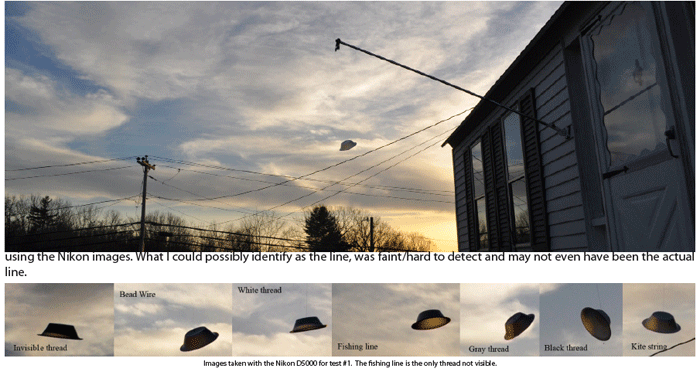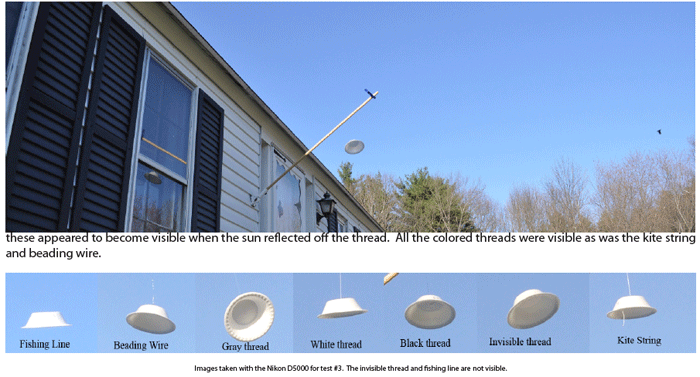.
23.07.2014

The Trent UFO Photos / McMinnville, Oregon - May 11, 1950

.
A few months ago, Robert Sheaffer and I were exchanging e-mails about the Trent photographs. I had mentioned that I had taken some photographs with a digital SLR of an aluminum pie pan suspended by some fishing line. Some showed the thread but others did not. The sky was very clear and blue, which helped in providing contrast to expose the line. Robert suggested it would be an interesting test to see what color and size threads would show up under varying lighting conditions. As a result, I conducted a series of tests to see what exactly might be hidden under certain lighting conditions.
.

The test
Beside fishing line, I thought it might be best to test a variety of threads and lines under varying light conditions. I also decided to use four different cameras. This table identifies the different threads and cameras used:

The model was a simple Styrofoam bowl suspended underneath a pole. All photos were taken from an approximate distance of 14-15 feet and two photographs were taken of each setup. I used the widest angle lens setting on each camera and set the exposure time setting to automatic. In the case of the Digital SLRs, I took RAW images that would produced uncompressed images for greatest resolution.
Test results
My first attempt at this test was a shot of the evening sky with the bright western sky backlighting the model. The sky was mostly clear ,with some cirrus, and the sun was obscured by my house. I was somewhat disappointed as the only thread that escaped scrutiny in the images was the fishing line. All cameras were unable to resolve it. The invisible thread escaped visual detection half the time in all the cameras except the Nikon, which resolved it in both shots. I attempted to locate the fishing line with Photoshop
.


My third attempt involved a clear evening sky but I took the images looking eastward vice westward. This put the sun behind me the same way one might get from shooting west in the morning. The fishing line continued to do well but it failed when the FujiFinePix
camera caught the sun glinting off the line. This did not show up in any of the other camera photographs. The invisible thread lived up to its name for most of the shots. It was visible in one Nikon and one cell phone camera image. Like the fishing line,
.

Preliminary conclusions
What these initial tests demonstrate is that threads can avoid detection if the lighting allows it. It appears that sunlight coming from a right angle to the camera is the best condition for hiding these threads. If the sun is in the same general direction as the photograph or behind the photographer, it will allow many threads to become easier to detect.
While these tests used a variety of digital cameras, it does not replicate the kind of images one might get from a film camera. Next issue, I plan on performing similar tests using black and white film and my old 35mm/Holga cameras. Before I do that, I will have to clean off all the dust.
.

Quelle: SUNlite 3/2013
.
Fortsetzung: 30.07.2014
.
String theory part II
Last issue, I described my efforts on detecting model UFOs suspended by string using various digital cameras. This issue, I continued
the testing using film cameras. Unfortunately, my old 35mm camera failed to work properly and only one section of the film was exposed. However, I was able to use the 6X6 format Holga camera and obtained some interesting results.
The Holga camera
The Holga camera is not the best camera for high resolution work. It is a cheap camera with a plastic lens. However, it does use large format film, which is a plus. This image demonstrates the resolution/focus of the Holga compared to the 35mm camera.

Both images were taken using Tmax 400 film. The 35mm tended to perform just a tad better than the Holga. Most of this had to do with the lens, which was a 50mm glass lens compared to the 60 mm plastic lens of the Holga (which is equivalent to a 35mm wide angle lens using 35mm film). Additionally, the Holga’s design tends to create a softer focus the further one is from the center of the negative.
Results
I performed the test during daylight around noon local time on a sunny day using the same models and strings as before. After the film was exposed and developed, I had the negatives scanned. I then examined the scanned negatives with a computer and the original negatives using an 8X loupe.


The results were about as I expected. The Holga was not quite as capable as the digital cameras in resolving the threads. The black thread was obvious even when examining the negative with the naked eye. However, all the other threads were nearly or completely
invisible. The bead wire did resolve itself with some adjustment of the levels in photoshop. The one 35mm photograph was of the bead wire (see below). It was not visible until I adjusted the levels on the scanned image. I was surprised that the white thread was not resolved by the Holga because in all the images taken with the digital cameras, under similar conditions, the thread could be seen. I can only assume this had something to do with the thread blending into the bright sky background.

Conclusions
In my opinion, the film cameras did not perform as well as the digital ones. Even the cell phone seemed to perform better. I was disappointed that the 35mm camera malfunctioned and did not get another chance to retest it before publishing this issue. To put the matter to rest, I intend to perform the test again with the 35mm in time for next issue.
Quelle: SUNlite 4/2013
.
Fortsetzung 3.08.2014
.
String theory part III
This is the final part of my tests involving strings and models. Last issue I tried to complete the tests using black and white TMax400 film (35mm format) but the 35mm camera had malfunctioned. I managed to perform most of the tests recently using the same film and lens (50mm) from a distance of about 16 feet. I ran out of film before I performed the tests on the fishing line and Invisible thread but these threads were difficult to detect using a digital SLR. I seriously doubt that the film camera would be able to resolve them based on the results I obtained with this latest round of tests.
Results
The results were similar to the results I obtained with the Holga in the last article. The black and the white threads were easily visible. The bead wire was visible with some enhancement in Photoshop. However, the grey thread and the kite string were not visible in any of the images I had. I am sure microscopic examination of the negative or some special software might reveal the threads but, at first glance, some of these strings appear to be good enough to fool many people into think the negatives show a real flying saucer hovering in the air.

Conclusions
What I have learned from all of my tests is that the background and lighting conditions can affect on how easily a thread will be detected. While some threads (black and white) can readily be detected under most lighting conditions, others are more difficult. I found the fact that the grey thread and kite string were difficult to detect in film cameras interesting to say the least. It implies that, under the right conditions, one can produce a fake UFO photograph using some simple thread as long as it is the right color and dimension that allows it to escape detection. Iconic UFO images like the Trent and Heflin photographs could have been produced this way. They may have been hoaxes that eventually got out of hand. Once they became big news, it would be hard for the photographers to back out and reveal that they were just goofing around with their cameras to see if they could trick people.
Quelle: SUNlite 5/2013

4917 Views
